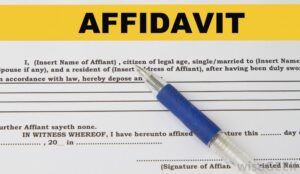Writing a check to yourself from one of your personal bank accounts to deposit in another isn’t uncommon, and it’s totally legal. To accomplish this, simply fill out the check, as usual, indicating yourself as the payee. The cheque can then be deposited into any of your other accounts that allow check deposits. Below, however, is a more comprehensive guide on how to go about this seamlessly; including other cash withdrawal and deposit options to leverage.
Why Would Anyone Write a Personal Check?
Before we get into why you’d write a check to yourself, it’s important to understand how checks work. First and foremost, there are various different types of checks, but the concept is the same. In most cases, the bank must first confirm that the check’s amount is accessible on the account holder’s balance. This is how cashier’s, private, and certified checks work. The difference, however, is that the funds in the latter circumstance are frozen but remain part of the account holder’s balance.
Checks are an alternative to electronically transferring funds from one account to another. There is no way to reverse the process after the payee withdraws money from a bank, ATM, cashier, or any other location. However, if there is no balance on the indicated account on the due date, fines may apply.
Returning to the subject of writing a check to oneself; transaction policy is the reason why people do this. It is not always possible to transfer money from one account to another on the same day. You might get the money after three days, depending on the bank’s policy and a few other conditions. For instance, if you transferred the money from one account to another on Friday afternoon, the transaction will not be completed until Monday. This is a result of the bank’s clearance policy, as well as international labor legislation. To put it another way, the transfer essentially eliminates the weekend.
Read Also: THEFT OF SERVICES: Examples, Defenses Penalties, and Sentence In Texas
If you write a check to yourself, on the other hand, you might get the money the same day or the next day. Let’s say you have money in one account and wish to use it to pay for a service or a product, but you can’t. For whatever reason, the type of payment card (debit, credit, etc.) isn’t supported for that transaction. It would take time to transfer money from that account to another, but then you need the product/service the same day. Basically, you can cash the check in that instance since you are both the payee and the payer. After that, deposit the check and transfer the funds to the appropriate account, and the transaction is complete!
Furthermore, it’s also a secure way to deposit money into an account directly at the counter. If you don’t have access to a bank account at the time, but you still need to send money, you can do it with a check. Simply visit a bank, request a check, fill it out, and deposit the funds. Even if you don’t have an account with them, you’re basically using them as the payee.
How to Write a Check to Yourself
Now that you’ve figured out why individuals do it, you’re probably wondering how to write a check to yourself. The procedure is the same as if you were writing a check to someone else’s account. Under the “pay to the order of” area, you write the payee’s name, the amount, and your signature.
The check can be obtained by visiting your bank and speaking with a clerk or staff. Of course, you won’t be able to get an infinite number of checks. This is because each bank has its own policy, and the number of checks offered varies. It is determined by your income as well as other considerations like the length of time you have had an account with that bank, your work status, and so on.
Meanwhile, in a more comprehensive form, stick to the following steps;
#1. Write the Check
To write the check, fill it out as you would any other check, and write your name on the “Pay to the order of” line (or similar). You can alternatively write the check payable to “Cash,” but this is tricky because anyone who has it will be able to cash or deposit it, so a misplaced or stolen check can cause problems. Afterward, enter the amount in question.
#2. Deposit the Check
The deposit can be made in a number of ways:
- By using your mobile device and your bank’s app to take a picture of the cheque
- By using an ATM to deposit the check
- Personally delivering the check to your bank (or mailing it in
#3. Cash the Check
If the check is for cash, endorse it when you’re ready to cash it at your bank or credit union. Sign your name on the back and provide identification to the teller to do so. You’ll almost certainly need to include your bank account number below your name. You may be able to cash the check just at your own bank but check cashing stores, grocery stores, and other banks may also be options.
Is Writing a Check in Your Name Illegal?
So the only question is: can you write a check to yourself and have no repercussions? It is not illegal to write a check to yourself. Simply put, you’re initiating a transaction from one bank to another, using two different accounts that are both in your name. However, there may be implications in some cases.
To a large extent, there is no requirement for clearing because the bank guarantees the funds, hence you must pay attention to the check’s date. For example, if you write tomorrow’s date on a check and spend the money on that account by that time tomorrow, the bank will charge you the amount plus additional fees. This is why it’s vital to have the funds in your account prior to the due date, which leads to another question:
Is it possible for me to write a check to myself if I don’t have any money in my account?
The short answer is yes and the procedure is as follows:
- The check is issued by the bank.
- You fill out the check and pay for the goods and services.
- The money is obtained from the bank by the retailed.
- On the selected date, the amount stated on the check is reimbursed from your account.
In other words, the bank loans the money to you as the endorser. The bank will pay the money to whoever the payee is, but they will need you to back it up with funds from your account. They will charge you if you can’t back it up because you don’t have the money, despite the fact that you have an account.
On the other hand, check kiting is when you write a check knowing you don’t have any money in your account. It’s also against the law. It’s a deceptive practice that allows people to take advantage of the system and gain access to funds that would otherwise be unavailable. As a result, rather than being used as a negotiating instrument, checks are now being used to get unlawful credit. When customers pay with a check, the system merely requires the presence of the account printed on the check at the time of payment.
In other words, the idea of “writing myself a check” is only prohibited if you do so knowing that you do not have any available funds in your account.
If you need cash, I strongly advise you to use an ATM, travel to a bank, or withdraw cash from a store by making a little purchase (just know that this store will likely impose limitations on your cash withdrawal).
Alternative Means Against Checks
Other methods of transferring monies across accounts exist, and I’ll go over a few of them below.
#1. Bank transfers
If you want to transfer money between two accounts at the same bank, o different banks, it is advisable that you do it electronically. Simply log into your online banking account and initiate a transfer; in many cases, it will be processed right away. This is by far the simplest way to get this done.
#2. ACH (Automated Clearing House)
Simply transferring funds electronically between financial institutions is one of the most prevalent procedures. An ACH (Automated Clearing House) transfer is commonly used for this. Several banks will let you add an external account and link it to your bank account so that you can move money between them. You can often do this for free with both small and large banking institutions, so always inquire.
However, the most important thing to remember about this procedure is that it can take several days to a week to link the accounts. Sometimes you may simply log into the external account and link the accounts, but other times you’ll need to go through verification or even make a test deposit to validate the account.
#3. P2P Transfers
P2P transfers are offered by several institutions as a way to speed up the transfer procedure.
You can quickly transfer funds to a variety of banking institutions for no price using this method.
These transfers have some restrictions, but they are fairly generous and even allow transfers between business accounts.
For starters, using a service like PayPal or VenMo is one of the simplest ways to transfer money between accounts. Setting up an account with these services is simple; all you need is your routing and account numbers, as well as an email address. You’ll be able to transfer and receive money between banks once you’ve linked your bank accounts.
#4. Wire Transfers
You can also use a wire transfer to move funds to another account. Wire transfers, on the other hand, are usually charged. These fees can be pretty substantial at times, and you might easily end yourself paying as high as $20 or more just to initiate a simple wire transfer.
Premium bank accounts, such as Chase Private Client, allow you to make wire transfers for free.
#5. Joint Bank Accounts
You can also write a check to yourself or the other designated individual on the bank account if you have a joint bank account. For example, if Dan and Tyler were married, Dan could write a check to Tyler and Tyler may deposit it into a different bank account.
#6. Business Accounts
You can write a check to yourself from your business account if you’re a small business owner like me. The most important criterion is that you have the authority to sign a check from your company’s account.
You should have established who has this power when you set up your bank account, and if you run a small business on your own, chances are you have already done so.
Keep in mind that corporate finances are not a smart idea, so if you do this, make sure to document everything thoroughly in case something goes wrong in the future.
Conclusion
It is evident from the preceding discussion that writing a check to yourself can be a convenient way to transfer money from one bank to another. As a result, it would be beneficial if you did not go to another bank with cash or pay wire transfer fees to get funds from another bank.
When you create a check for yourself, however, you must ensure that there are sufficient funds in your existing account when you deposit the check. When the receiving bank accepts the bad check, your check will bounce.



